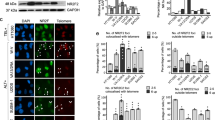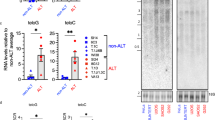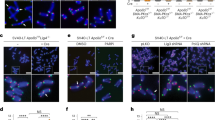Abstract
Telomerase-negative cancer cells can maintain their telomeres by a recombination-mediated alternative lengthening of telomeres (ALT) process. We reported previously that sequestration of MRE11/RAD50/NBS1 complexes represses ALT-mediated telomere length maintenance, and suppresses formation of ALT-associated promyelocytic leukemia (PML) bodies (APBs). APBs are PML bodies containing telomeric DNA and telomere-binding proteins, and are observed only in a small fraction of cells within asynchronously dividing ALT-positive cell populations. Here, we report that methionine restriction caused a reversible arrest in G0/G1 phase of the cell cycle and reversible induction of APB formation in most cells within an ALT-positive population. We combined methionine restriction with RNA interference to test whether the following proteins are required for APB formation: PML body-associated proteins, PML and Sp100; telomere-associated proteins, TRF1, TRF2, TIN2 and RAP1; and DNA repair proteins, MRE11, RAD50, NBS1 and 53BP1. APB formation was not decreased by depletion of Sp100 (as reported previously) or of 53BP1, although 53BP1 partially colocalizes with APBs. Depletion of the other proteins suppressed APB formation. Because of the close linkage between ALT-mediated telomere maintenance and ability to form APBs, the eight proteins identified by this screen as being required for APB formation are also likely to be required for the ALT mechanism.
This is a preview of subscription content, access via your institution
Access options
Subscribe to this journal
Receive 50 print issues and online access
$259.00 per year
only $5.18 per issue
Buy this article
- Purchase on Springer Link
- Instant access to full article PDF
Prices may be subject to local taxes which are calculated during checkout







Similar content being viewed by others
References
Anderson L, Henderson C, Adachi Y . (2001). Phosphorylation and rapid relocalization of 53BP1 to nuclear foci upon DNA damage. Mol Cell Biol 21: 1719–1729.
Blow JJ, Hodgson B . (2002). Replication licensing – defining the proliferative state? Trends Cell Biol 12: 72–78.
Brachner A, Sasgary S, Pirker C, Rodgarkia C, Mikula M, Mikulits W et al. (2006). Telomerase- and alternative telomere lengthening-independent telomere stabilization in a metastasis-derived human non-small cell lung cancer cell line: effect of ectopic hTERT. Cancer Res 66: 3584–3592.
Bryan TM, Englezou A, Dalla-Pozza L, Dunham MA, Reddel RR . (1997). Evidence for an alternative mechanism for maintaining telomere length in human tumors and tumor-derived cell lines. Nat Med 3: 1271–1274.
Bryan TM, Englezou A, Gupta J, Bacchetti S, Reddel RR . (1995). Telomere elongation in immortal human cells without detectable telomerase activity. EMBO J 14: 4240–4248.
Cerone MA, Autexier C, Londono-Vallejo JA, Bacchetti S . (2005). A human cell line that maintains telomeres in the absence of telomerase and of key markers of ALT. Oncogene 24: 7893–7901.
de Lange T . (2002). Protection of mammalian telomeres. Oncogene 21: 532–540.
de Lange T . (2005). Shelterin: the protein complex that shapes and safeguards human telomeres. Genes Dev 19: 2100–2110.
Dunham MA, Neumann AA, Fasching CL, Reddel RR . (2000). Telomere maintenance by recombination in human cells. Nat Genet 26: 447–450.
Fasching CL, Bower K, Reddel RR . (2005). Telomerase-independent telomere length maintenance in the absence of ALT-associated PML bodies. Cancer Res 65: 2722–2729.
Gerdes J, Lemke H, Baisch H, Wacker HH, Schwab U, Stein H . (1984). Cell cycle analysis of a cell proliferation-associated human nuclear antigen defined by the monoclonal antibody Ki-67. J Immunol 133: 1710–1715.
Gerdes J, Schwab U, Lemke H, Stein H . (1983). Production of a mouse monoclonal antibody reactive with a human nuclear antigen associated with cell proliferation. Int J Cancer 31: 13–20.
Goldberg M, Stucki M, Falck J, D'Amours D, Rahman D, Pappin D et al. (2003). MDC1 is required for the intra-S-phase DNA damage checkpoint. Nature 421: 952–956.
Gonzalo S, Jaco I, Fraga MF, Chen T, Li E, Esteller M et al. (2006). DNA methyltransferases control telomere length and telomere recombination in mammalian cells. Nat Cell Biol 8: 416–424.
Greider CW, Blackburn EH . (1985). Identification of a specific telomere terminal transferase activity in Tetrahymena extracts. Cell 43: 405–413.
Grobelny JV, Godwin AK, Broccoli D . (2000). ALT-associated PML bodies are present in viable cells and are enriched in cells in the G2/M phase of the cell cycle. J Cell Sci 113: 4577–4585.
Halpern BC, Clark BR, Hardy DN, Halpern RM, Smith RA . (1974). The effect of replacement of methionine by homocystine on survival of malignant and normal adult mammalian cells in culture. Proc Natl Acad Sci USA 71: 1133–1136.
Henson JD, Hannay JA, McCarthy SW, Royds JA, Yeager TR, Robinson RA et al. (2005). A robust assay for alternative lengthening of telomeres (ALT) in tumors demonstrates the significance of ALT in sarcomas and astrocytomas. Clin Cancer Res 11: 217–225.
Houghtaling BR, Cuttonaro L, Chang W, Smith S . (2004). A dynamic molecular link between the telomere length regulator TRF1 and the chromosome end protector TRF2. Curr Biol 14: 1621–1631.
Iwabuchi K, Bartel PL, Li B, Marraccino R, Fields S . (1994). Two cellular proteins that bind to wild-type but not mutant p53. Proc Natl Acad Sci USA 91: 6098–6102.
Jiang WQ, Zhong ZH, Henson JD, Neumann AA, Chang AC, Reddel RR . (2005). Suppression of alternative lengthening of telomeres by Sp100-mediated sequestration of MRE11/RAD50/NBS1 complex. Mol Cell Biol 25: 2708–2721.
Johnson FB, Marciniak RA, McVey M, Stewart SA, Hahn WC, Guarente L . (2001). The Saccharomyces cerevisiae WRN homolog Sgs1p participates in telomere maintenance in cells lacking telomerase. EMBO J 20: 905–913.
Judde JG, Ellis M, Frost P . (1989). Biochemical analysis of the role of transmethylation in the methionine dependence of tumor cells. Cancer Res 49: 4859–4865.
Kamei H . (1996). Reversible large-body formation from nuclear bodies upon amino acid(s) starvation in T24 cells. Exp Cell Res 224: 302–311.
Kamei H . (1997). Cystine starvation induces reversible large-body formation from nuclear bodies in T24 cells. Exp Cell Res 237: 207–216.
Karlseder J, Broccoli D, Dai Y, Hardy S, de Lange T . (1999). p53- and ATM-dependent apoptosis induced by telomeres lacking TRF2. Science 283: 1321–1325.
Kim SH, Beausejour C, Davalos AR, Kaminker P, Heo SJ, Campisi J . (2004). TIN2 mediates functions of TRF2 at human telomeres. J Biol Chem 279: 43799–43804.
Lei M, Tye BK . (2001). Initiating DNA synthesis: from recruiting to activating the MCM complex. J Cell Sci 114: 1447–1454.
Li B, de Lange T . (2003). Rap1 affects the length and heterogeneity of human telomeres. Mol Biol Cell 14: 5060–5068.
Li B, Oestreich S, de Lange T . (2000). Identification of human Rap1: implications for telomere evolution. Cell 101: 471–483.
Lu S, Epner DE . (2000). Molecular mechanisms of cell cycle block by methionine restriction in human prostate cancer cells. Nutr Cancer 38: 123–130.
Marciniak RA, Cavazos D, Montellano R, Chen Q, Guarente L, Johnson FB . (2005). A novel telomere structure in human alternative lengthening of telomeres cell line. Cancer Res 65: 2730–2737.
Mecham JO, Rowitch D, Wallace CD, Stern PH, Hoffman RM . (1983). The metabolic defect of methionine dependence occurs frequently in human tumor cell lines. Biochem Biophys Res Commun 117: 429–434.
Molenaar C, Wiesmeijer K, Verwoerd NP, Khazen S, Eils R, Tanke HJ et al. (2003). Visualizing telomere dynamics in living mammalian cells using PNA probes. EMBO J 22: 6631–6641.
Moran-Jones K, Wayman L, Kennedy DD, Reddel RR, Sara S, Snee MJ et al. (2005). hnRNP A2, a potential ssDNA/RNA molecular adapter at the telomere. Nucleic Acids Res 33: 486–496.
Murnane JP, Sabatier L, Marder BA, Morgan WF . (1994). Telomere dynamics in an immortal human cell line. EMBO J 13: 4953–4962.
Nabetani A, Yokoyama O, Ishikawa F . (2004). Localization of hRad9, hHus1, hRad1 and hRad17, and caffeine-sensitive DNA replication at ALT (alternative lengthening of telomeres)-associated promyelocytic leukemia body. J Biol Chem 279: 25849–25857.
O'Connor MS, Safari A, Liu D, Qin J, Songyang Z . (2004). The human Rap1 protein complex and modulation of telomere length. J Biol Chem 279: 28585–28591.
Pavillard V, Drbal AA, Swaine DJ, Phillips RM, Double JA, Nicolaou A . (2004). Analysis of cell-cycle kinetics and sulfur amino acid metabolism in methionine-dependent tumor cell lines; the effect of homocysteine supplementation. Biochem Pharmacol 67: 1587–1599.
Perrem K, Colgin LM, Neumann AA, Yeager TR, Reddel RR . (2001). Coexistence of alternative lengthening of telomeres and telomerase in hTERT-transfected GM847 cells. Mol Cell Biol 21: 3862–3875.
Rappold I, Iwabuchi K, Date T, Chen J . (2001). Tumor suppressor p53 binding protein 1 (53BP1) is involved in DNA damage-signaling pathways. J Cell Biol 153: 613–620.
Rogan EM, Bryan TM, Hukku B, Maclean K, Chang ACM, Moy EL et al. (1995). Alterations in p53 and p16INK4 expression and telomere length during spontaneous immortalization of Li-Fraumeni syndrome fibroblasts. Mol Cell Biol 15: 4745–4753.
Schultz LB, Chehab NH, Malikzay A, Halazonetis TD . (2000). p53 binding protein 1 (53BP1) is an early participant in the cellular response to DNA double-strand breaks. J Cell Biol 151: 1381–1390.
Silverman J, Takai H, Buonomo SB, Eisenhaber F, de Lange T . (2004). Human Rif1, ortholog of a yeast telomeric protein, is regulated by ATM and 53BP1 and functions in the S-phase checkpoint. Genes Dev 18: 2108–2119.
Smyth CM, Helmer MA, Dalla-Pozza L, Rowe PB . (1993). Flow cytometric DNA analyses of frozen samples from children's solid tumors. Pathology 25: 388–393.
Stavropoulos DJ, Bradshaw PS, Li X, Pasic I, Truong K, Ikura M et al. (2002). The Bloom syndrome helicase BLM interacts with TRF2 in ALT cells and promotes telomeric DNA synthesis. Hum Mol Genet 11: 3135–3144.
Stern PH, Hoffman RM . (1984). Elevated overall rates of transmethylation in cell lines from diverse human tumors. In Vitro 20: 663–670.
Stern PH, Hoffman RM . (1986). Enhanced in vitro selective toxicity of chemotherapeutic agents for human cancer cells based on a metabolic defect. J Natl Cancer Inst 76: 629–639.
Takai H, Smogorzewska A, de Lange T . (2003). DNA damage foci at dysfunctional telomeres. Curr Biol 13: 1549–1556.
Tarsounas M, Munoz P, Claas A, Smiraldo PG, Pittman DL, Blasco MA et al. (2004). Telomere maintenance requires the RAD51D recombination/repair protein. Cell 117: 337–347.
Tisdale MJ . (1980). Effect of methionine deprivation on methylation and synthesis of macromolecules. Br J Cancer 42: 121–128.
Toouli CD, Huschtscha LI, Neumann AA, Noble JR, Colgin LM, Hukku B et al. (2002). Comparison of human mammary epithelial cells immortalized by simian virus 40 T-Antigen or by the telomerase catalytic subunit. Oncogene 21: 128–139.
van Steensel B, de Lange T . (1997). Control of telomere length by the human telomeric protein TRF1. Nature 385: 740–743.
van Steensel B, Smogorzewska A, de Lange T . (1998). TRF2 protects human telomeres from end-to-end fusions. Cell 92: 401–413.
Wang RC, Smogorzewska A, de Lange T . (2004). Homologous recombination generates T-loop-sized deletions at human telomeres. Cell 119: 355–368.
Wu G, Jiang X, Lee WH, Chen PL . (2003). Assembly of functional ALT-associated promyelocytic leukemia bodies requires Nijmegen breakage syndrome 1. Cancer Res 63: 2589–2595.
Wu G, Lee WH, Chen PL . (2000). NBS1 and TRF1 colocalize at promyelocytic leukemia bodies during late S/G2 phrases in immortalized telomerase-negative cells. Implication of NBS1 in alternative lengthening of telomeres. J Biol Chem 275: 30618–30622.
Xu L, Blackburn EH . (2004). Human Rif1 protein binds aberrant telomeres and aligns along anaphase midzone microtubules. J Cell Biol 167: 819–830.
Xu ZX, Timanova-Atanasova A, Zhao RX, Chang KS . (2003). PML colocalizes with and stabilizes the DNA damage response protein TopBP1. Mol Cell Biol 23: 4247–4256.
Yankiwski V, Marciniak RA, Guarente L, Neff NF . (2000). Nuclear structure in normal and Bloom syndrome cells. Proc Natl Acad Sci USA 97: 5214–5219.
Ye JZ, de Lange T . (2004). TIN2 is a tankyrase 1 PARP modulator in the TRF1 telomere length control complex. Nat Genet 36: 618–623.
Ye JZ, Donigian JR, Van Overbeek M, Loayza D, Luo Y, Krutchinsky AN et al. (2004). TIN2 binds TRF1 and TRF2 simultaneously and stabilizes the TRF2 complex on telomeres. J Biol Chem 279: 47264–47271.
Yeager TR, Neumann AA, Englezou A, Huschtscha LI, Noble JR, Reddel RR . (1999). Telomerase-negative immortalized human cells contain a novel type of promyelocytic leukemia (PML) body. Cancer Res 59: 4175–4179.
Zhu XD, Kuster B, Mann M, Petrini JH, de Lange T . (2000). Cell-cycle-regulated association of RAD50/MRE11/NBS1 with TRF2 and human telomeres. Nat Genet 25: 347–352.
Zhu XD, Niedernhofer L, Kuster B, Mann M, Hoeijmakers JH, de Lange T . (2003). ERCC1/XPF removes the 3′ overhang from uncapped telomeres and represses formation of telomeric DNA-containing double minute chromosomes. Mol Cell 12: 1489–1498.
Acknowledgements
We thank Christine Smyth for FACS analysis and Axel Neumann for technical advice. This work was supported by a project grant from the Cancer Council New South Wales.
Author information
Authors and Affiliations
Corresponding author
Additional information
Supplementary Information accompanies the paper on the Oncogene website (http://www.nature.com/onc).
Rights and permissions
About this article
Cite this article
Jiang, WQ., Zhong, ZH., Henson, J. et al. Identification of candidate alternative lengthening of telomeres genes by methionine restriction and RNA interference. Oncogene 26, 4635–4647 (2007). https://doi.org/10.1038/sj.onc.1210260
Received:
Revised:
Accepted:
Published:
Issue Date:
DOI: https://doi.org/10.1038/sj.onc.1210260
Keywords
This article is cited by
-
Alternative lengthening of telomeres (ALT) cells viability is dependent on C-rich telomeric RNAs
Nature Communications (2023)
-
Alternative lengthening of telomeres: from molecular mechanisms to therapeutic outlooks
Cell & Bioscience (2020)
-
TelNet - a database for human and yeast genes involved in telomere maintenance
BMC Genetics (2018)
-
One-carbon metabolites and telomere length in a prospective and randomized study of B- and/or D-vitamin supplementation
European Journal of Nutrition (2017)
-
TRF1 phosphorylation on T271 modulates telomerase-dependent telomere length maintenance as well as the formation of ALT-associated PML bodies
Scientific Reports (2016)



